France
Victor ROV
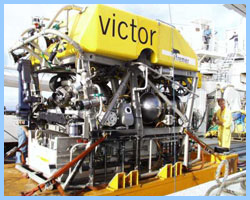 |
Operator: IFREMER Further Information In service since 1999, Victor 6000 is a deep-water ROV remotely operated by cable. It carries out observation and handling tasks to a depth of 6,000 meters.Designed specifically for scientific oceanographic works, the submersible is equipped with a high-performance navigation system that comprises a range of sensors connected to an inertial navigation system. Its high-resolution optical imaging system (photo and video) ensures an optimal visual perception of the environment. Victor 6000 can also generate optical 3D reconstructions of the area under observation. The remotely operated submersible Victor 6000 offers the scientific community a deep-water device (6000 metres) that can:
Victor 6000 is a modular and remotely operated deep-water system fitted with instruments. It can generate high-quality optical imaging, as well as carry and operate a diverse range of scientific equipment and tools. The submersible is connected to the ship by an electromechanical cable which is 8,000 metres long and supplies 20 kW of electrical power. Optical fibres in the cable send the data and image flows to the surface, thus providing the pilots and scientific teams with complete access. The control room, housed in a 20’ container placed on the ship enables the submersible to be piloted in real-time. In theory, there is no limit to the duration of a dive, which means the pilots can adopt a 4-hour watch system (2 people per watch). Characteristics:
|
AUV AsterX & IdefX
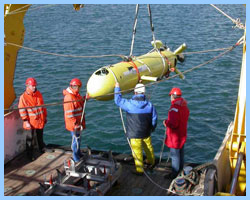 |
Operator: IFREMER Further Information The submersibles Asterx and Idefx are autonomous underwater vehicles (AUV) designed for the scientific reconnaissance of continental shelves to a depth of 2,850 metres. They perform dives without any physical connection to the surface vessel and do not require an operator. These medium-sized vehicles can deploy scientific payloads on sections of up to 100 km in length. They have at their disposal a catalogue of payloads, including multibeam echo sounders, sub-bottom profilers, current profilers, CTD, magnetometers, and other “user” embarked equipment, which can be leveraged thanks to adaptable interfaces. Their suitability for coastal vessels means they can be deployed quickly and at a reasonable cost. In deep-sea contexts, they can be used to improve the efficiency of “heavy” submersibles (Victor 6000, Nautile) by generating high-resolution charts and data relating to diving targets. Characteristics:
|
Nautile SUB
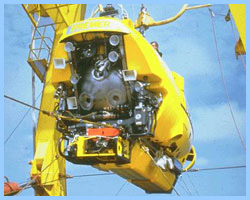 |
Operator: IFREMER Further Information The Nautile is a manned submarine that can dive to a depth of 6,000 metres with a crew of three. It is one of the very few manned deep-sea submarines. Three wide-angle viewports and LED searchlights provide a direct view of the seabed. It could be used for:
The Nautile is a versatile vehicle that can be deployed quickly in difficult environments thanks to its capacity for providing a direct view of its surroundings and the absence of any physical link to the support vessel. A dive can last up to eight hours, of which six can be spent working on the sea floor. The relatively small size of the manned submarine Nautile belies its diving and carrying capacities. It can be operated by any vessel equipped with a twenty-tonne stern gantry, such as RV Pourquoi Pas? and RV L'Atalante. Characteristics:
|
PENFELD Penetrometer
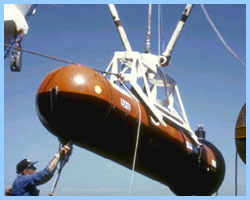 |
Operator: IFREMER Further Information The penetrometer PENFELD is a geotechnical measuring device. Once in position on the seabed, it takes measurements in the sediment using a rod fitted with instruments. The penetrometer’s maximum working depth is 6000 m. It features a rod that penetrates the sediment to a depth of 30m and recently extended to 50m. The rod is 36 mm in diameter and is wound around a 2.20 m diameter drum. It is straightened during penetration using the coiled tubing technique. A bearing cable connects the device to the vessel. It is powered by pressure-equalizing lead batteries. Characteristics:
|
Germany
Kiel 6000 ROV
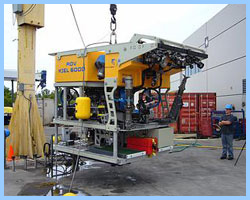 Operator: GEOMAR
Operator: GEOMAR
Further Information
The ROV KIEL 6000 (remotely operated vehicle) has been designed for scientific purposes with an operational depth rating of 6000m.
Remote control, data communication and live video streams are facilitated by a deep-sea glass fibre cable. The glass fibres are enclosed in a 19mm thick cable which also provides the electrical power for the thruster, hydraulics, cameras and lights.
The vehicle is an electrically powered work class (class III) ROV which has been manufactured by Schilling Robotics, LLC, Davis, California. Its modular concept allows for different scientific payloads.
With a depth rating of 6000m it is capable of reaching 95% of the world’s seafloor. The ROV can be operated from ships of opportunity which fullfill certain requirements like dynamic positioning (DP), bearing capacity, electric and crane/winch capacity.
KIEL 6000 will be used for multidisciplinary scientific projects and for the installation and maintainance of ocean observatories.
Procurement of the ROV has been realised by the Schleswig-Holstein Fund.
PHOCA ROV
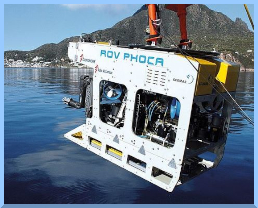 Operator: GEOMAR
Operator: GEOMAR
Further Information
The remotely operated vehicle ROV PHOCA is a deep diving platform rated for water depths of 3000 meters. The ROV is linked to a surface vessel via an umbilical cable transmitting power (copper wires) and data (3 single-mode glass bers). As standard it comes equipped with still and video cameras and two different manipulators providing eyes and hands in the deep. Special emphasis was put on the compatibility of numerous systems with the existing ROV KIEL 6000 to facilitate the use of both systems on various research vessels with a given team of ROV pilots. Besides this, a set of other tools may be added depending on the mission tasks, ranging from simple manipulative tools as chisels and shovels to electrically connected instruments which can send insitu data to the ship through the ROVs network, allowing immediate decisions upon manipulation or sampling strategies.
Netherlands
DEEP-SEA WINCH (Kley France)
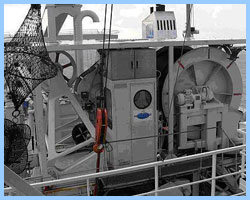 |
Operator: NIOZ Further Information Kevlar cabled traction winch for deep-sea work up to 8000 m. Special assistance is needed with this equipment. |
Ultra Clean CTD
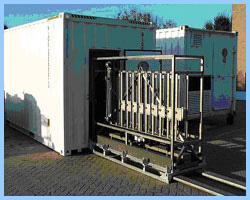 |
Operator: NIOZ Further Information To achieve contamination free seawater sampling and sub sampling in order to measure low concentrations of trace metals in seawater. For this reason A full titanium Ultra Clean CTD-frame, an Ultra Clean Container for sub-sampling and an clean transportation system to the Clean Container were developed. The Ultra Clean CTD Works normally in combination with the NIOZ Kevlar Cable Winch and GO-FLO CTD-bottles. |
Lab Containers
Operator: NIOZ
Further Information
Wet Lab Container: Standard 20 foot container, including ventilation and airco system.
Cooled Lab Container: Standard 20 foot container, including air-conditioning and ventilation system.
Clean Room Container: Standard 20 foot container, including air-conditioning, air filtration and ventilation system. Clean room class: 100 - 1.000.
Autoanalyzer Container: Standard 20 foot container, including ventilationsystem, airco, heating, Milli-RO and Milli-Q waterinstallation. Maximum 4 different nutrients can be analysed in 1 container with a maximum of 800 analyses per day.
Cool/Freeze Storage Container: Standard 20 foot container, including storage racks.
Office Container: Standard 20 foot container, including ventilation system.
Transport Container: Standard 20 foot container.
Special Purpose Containers:
- Oxygen & Salinity Analyzing lab
- Scanfish container
- Isotope laboratory
- Seismic Data Lab
- Ultra Clean CTD container
- XRF Core Scanner container
- Seismic Compressor container
- Isotope laboratory
Norway
Kley France Calypso Corer System
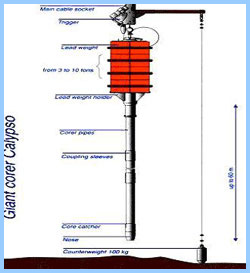 Operator: IMR
Operator: IMR
Further Information
The Calypso corer system was ordered from Kley France to be equipped on the new research vessel G.O. Sars, delivered April 2003. It consists of a corer sampler with a total weight of 3800 kg, a winch/drum and a control container. The Calypso corer is capable of making sedimental samples up to 22 meters at a depth of total 6000m, on the G.O. Sars version, and the 9 tonnes scientific winch is made for multi purpose use.
The winch and the drum is mounted on a 20ft container platform (separates into two 10ft platform to ease loading). The control is mounted in a 10ft container.
In addition to this there is a 10ft corer deployment platform, hydraulic adjustable, for launch/recovery operations.
The Calypso corer is released from the main cable approximately 1 meter above sea floor. An internal wire connected to a piston at the bottom of the corer helps neutralizing the pressure at impact and also connects the corer to main cable for recovery.
The system is powered by 440 VAC/ 60Hz.
ROV Ægir 6000
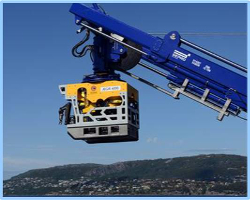 |
Operator: IMR Further Information Norway’s new scientific remotely operated vehicle (ROV) has been christened Ægir, after the old Norse god of the sea, Being one of the few vehicles in the world able to dive as deeply as 6,000 meters |
United Kingdom
ISIS
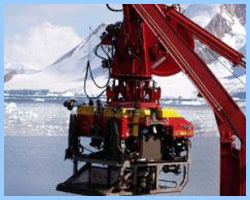 Operator: NERC
Operator: NERC
Further Information
ISIS is a remotely operated vehicle capable of descending to 6500m below the surface of the ocean.
An operator in the control van aboard the mother ship can guide the vehicle to precise locations by sending commands to the vehicle's thrusters. Once there the operator can use the ROV's manipulators like arms and hands to do scientific tasks such as taking samples and deploying instruments. The operator can view the sea floor through up to 8 separate cameras mounted on the vehicle.
ISIS also has sophisticated sonar systems to make high resolution bathymetry maps of the seafloor as well as chemical sensors and a 'slurp' gun to take mid water biological samples.
Autosub
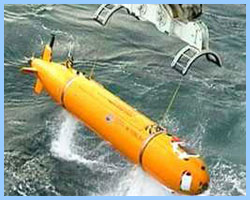 |
Operator: NERC Further Information Autonomous Underwater Vehicles (AUVs) are robot submarines, which are used to explore the world’s oceans without a pilot, or any tether. Before launch from the mother ship, the AUV’s computers are programmed with instructions of where to go, what to measure, and what depths to go to. With no link to the mother ship, all communications with the AUV are limited to using acoustics (sound) when the AUV is underwater (this typically has a range of a few km) or satellite communications (such as Iridium) can be used when the AUV is floating on the sea surface. |


